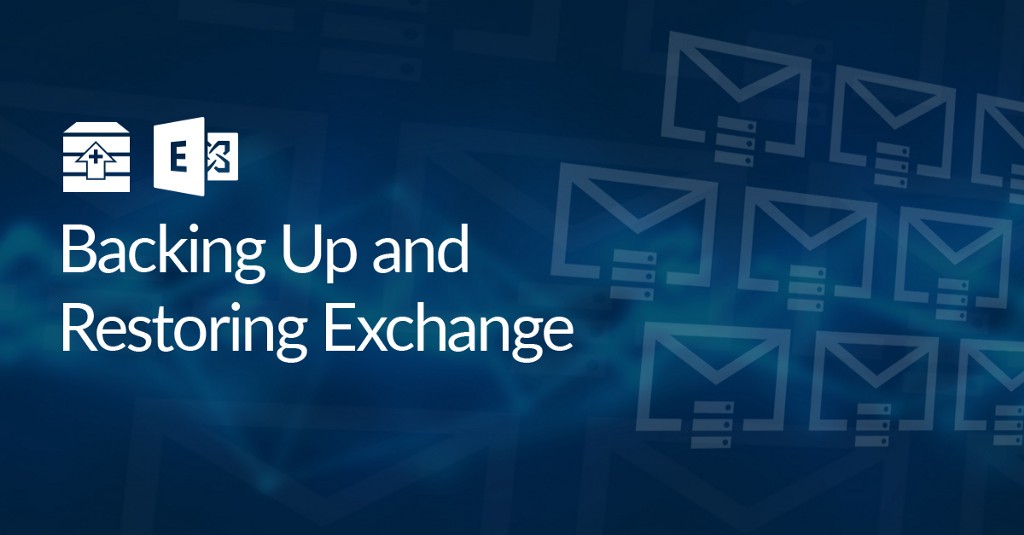Backing Up and Restoring Exchange


Macrium Reflect Server Plus contains several features that are useful when backing up data that is stored in an Exchange Database. This includes the ability to backup and restore individual databases and even restore individual mailboxes and items in those mailboxes. This blog post will cover how to backup and restore Exchange Databases, and some of the granularity that Macrium Reflect Server Plus offers.
To create a backup of your Exchange Database, you can either create an image of the disk that the Exchange Databases are located on, however, this does not offer the granularity of restoring one database to a point in time. If all the databases are stored on the same disk, when the image is restored, all the databases will be put back to the same point in time. Server Plus allows you to create a backup of each individual database. To do this select ‘Backup Microsoft Exchange’.

You will then be presented with a wizard showing all Exchange databases that are available to be backed up.

You can then select the databases that you want to backup and where the backup will be stored, you can also specify an ‘Alternative Location’ to be used as a destination, as a failsafe if the first destination is unavailable, or for backup drive rotation.
By selecting ‘View selected component files’, you can see the list of files that makes up the currently selected items, along with the last modified date and size of each.

Once you are happy with your selection, click ‘Next’.

The next page of the wizard is where you will create your backup schedule and define the retention rules that will be applied to it. Once you have configured these, select ‘Next’ to review the settings that you have selected.

Once you are happy with your settings, select ‘Finish’.
Restoring Exchange
When restoring your Exchange Database, there are several different ways you can do this.
Image Restore — If you have taken an image of the partition/disk where your exchange database is located, this can be restored, setting the Exchange Database to the point-in-time when that image was created. However, if you have more than one Exchange Database located on the partition/disk, this will also set these databases back to the point-in-time that the image was created.
Microsoft Exchange Restore — If you have backed up your Exchange Databases, you can restore a whole Exchange Database without altering other Exchange Databases. First select the ‘Restore’ tab in Reflect then select ‘Microsoft Exchange Restore’. Next you can choose each database that you want to restore.

By default, the most recent backup will be selected to restore. The ‘Backup Plan’ shows the backup files selected. The ‘Restore Summary’ lists all databases restoring and the date/time of the backup file to restore from. Clicking ‘Restore’ will then restore this database back to the original location.
You can also restore a backup of your databases back to a different a different location. This can be done by selecting ‘Restore to (database name)’.

This will open the ‘Select Restore Destination’ wizard.

Select ‘Restore to alternate location’. After selecting ‘Next’ you can specify the database that you want to restore to.

By following these steps, the database will be restored, without altering the other Exchange Databases.
Mailbox Restore — A mailbox restore allows you to restore individual emails from a backup of Microsoft Exchange. This is useful if the Exchange Backup contains useful emails or attachments that you want to retrieve, without restoring the whole database. In order to perform the Mailbox Restore, Microsoft Exchange MAPI and CDO must be installed on the Exchange Server for Exchange 2010 and earlier installations. For Exchange 2013 or later, we use EWS, which comes with Exchange by default. Occasionally a Visual C++ redistributable package is required, if this is redistributable is not present, you will receive an error message with a link to download the redistributable. The user that is running Macrium Reflect must also have full access permissions for the mailbox that is being restored to and an existing mailbox must be present with the same name (a new mailbox will not be created). The steps that are required to set the mailbox permissions can be found at the article below:
https://knowledgebase.macrium.com/display/KNOW72/Setting+up+permissions+for+Mailbox+Restore
To perform the Mailbox Restore, select ‘Restore Exchange Mailboxes’ from the ‘Microsoft Exchange Restore’ tab.

Next, select the database, where the email and mailbox that you are restoring is located.

You will then be presented with a list of mailboxes that are in that database, by expanding this, you will be presented with a list of items that are stored in that mailbox.

Once you have selected the items/mailboxes that you want to restore, select ‘Restore’. The items that you selected will then be restored back to that mailbox.
Download a 30-Day Trial of Macrium Reflect Server Plus here.


